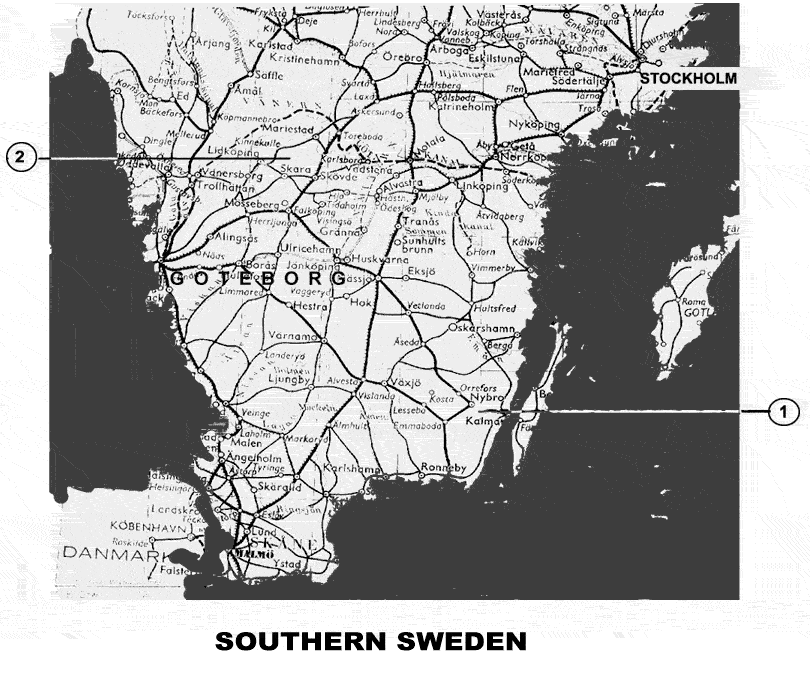
Vallsjöbol, Västergötland, is roughly in the location shown at #2 above.

Alf Gunnarson, of Skövde, Sweden, is my second cousin, or syssling. His mother's father and my mother's mother were siblings. Alf has excellent command of English, but my knowledge of Swedish is very sketchy. I thought I could improve on it by translating this piece, which is written with "the mind and comprehension of an 11-year-old." How hard could that be? Quite hard, as it turns out, if you have to look up almost every word in the dictionary. Even words I thought I knew turned out to have unexpected meanings. I've added a bunch of bracketed notes which may or may not help understand what Alf is writing.
Many of the place-names are not easily translatable, and the puns are
completely untranslatable. Here's a very brief summary on how to
pronounce Swedish:
The Swedish alphabet has three extra characters, å, ä, and
ö. The approximate pronunciation of some Swedish letters that are
different from English (there are a few exceptions) is:
A = "ah" (short "a" in English)
F = "v" in English, or sometimes "f"
O = "oo" (long "o" in English)
Ä = "aa" (long "a" in English, but sometimes more like a short "e")
Å = "oh" (short "o" in English)
Ö = "euh" (there's no sound like this in English: sort of like the
"ea" in "earl",
but without the "r" sound.
SJ = aspirated "wh" in southern Sweden (Gothaland), but "sh" in
Stockholm.
W = "v" in English
The entire land covered by the US Louisiana Purchase of 1803, including Minnesota, was laid out by surveyors in 6- x 6-mile townships with roads, typically one per mile, running in a strict north-south-east-west grid. The farms were also laid out in grids where the geography would allow it, and a typical farmhouse would be near the road, but if each set of farm buildings were placed in the center of one piece of land, a farmhouse would be typically a half-mile away from the next farmhouse on the same side of the road. Further west, houses were even more isolated. The location of towns was determined by the railroad, typically about one every ten miles. The logistics of steam locomotive coaling and watering were of more concern in these placements than convenience for the farmers.
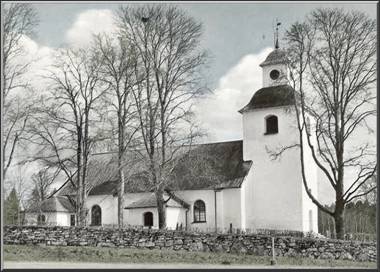 |
Organization of farms in southern Sweden was very different, an artifact of the old social system. Farmhouses tend to be in small clusters surrounded by the fields that those farmers use. Each tiny settlement has a place-name. Farm size runs from 40 to 200 acres. Roads that were probably surveyed and laid out by cows meander from place to place. Larger settlements, like Vallsjöbol and Barrud, are called bys (pronounced "bees"). They are still only the size of tiny towns in the US. The whole area described here by Alf (roughly equivalent to, but smaller than, what we'd call a township), is a rote. Vallsjöbol rote consisted of the town and the neighborhood from which Vallsjöbol school drew its students. Therefore, I've translated rote as "district." Several rotes were included in a parish, which usually was located in a church in a larger city. Finnerödja, for example, about 6 English miles away from Vallsjöbol, was the parish for the whole area. I was completely ignorant of the history of this arrangement, so I asked Alf about it. Below is his answer, which gives an idea of the wealth of his historical knowledge as well as his excellent command of English:
In the middle age, say 1200-1500, all the land in Finnerödja belonged to the monastery (abbey) of Riseberga (in Nerike) and there was less cultivated land then, of course. In Finnerödja there were two dominating culture-areas: Ramsnäs at Lake Unden and Skagersholm at Lake Skagern. Both Ramsnäs and Skagersholm were (small) estates and they ruled a lot of smaller farmyards, where farmers (yeomen) lived and earned their own living by natural economy. Vallsjön, at Lake Vallsjön, was a yet smaller estate and the settlement of Vallsjöbol was ruled from Vallsjön. But as I said before, the estates belonged to the Church, so there were a lot of small "pontificates" and "marshalls" all over the country.
In the 16th century Gustaf Vasa became king of Sweden (1523-1560), after he had been skiing in Dalarna and so on1. He started a big reduction of land from the Church to his own Kingdom. After that reduction, the state (Kronan) owned all land and it made no difference for those poor people who lived at the small farmyards -- they didn't own their land; they still were yeomen. After Karl XII had left (1718) there was a time that was called Frihetstiden (Time of liberty) and now the yeomen could be peasant proprietors, buying their land from the Crown. So did Erik Månsson2 of Mossebo in 1724 and so did a lot of other peasants at the same time.
Perhaps it could be interesting to know, that from the Middle Ages until 1866, there were four orders of society in Sweden: adel, präster, borgare and bönder (Nobility, priests, burghers and peasants). In 1866 those orders were substituted for a two-chamber's Riksdag (parliament), that existed about 100 years and was substituted for a one-chamber parliament in the 1950s. The diet of the Four Estates had their sessions only if it was needed--some kings thought it was not needed at all--and in the history of Years, we had to learn about the important sessions in school. There were two important sessions in 1527 and 1544 (both in Västerås) during Gustaf Vasa´s time. He did not only steal all land and richness from the Church, he also decided that Sweden should be a country of Protestants instead of Catholics. That was the decision of the meetings in Västerås 1527 and 1544. Sweden had a Martin Luther of their own—Laurentius Petri—who was the first Protestant archbishop of Sweden, if I am not mistaken. The poor people did not notice these changes much, as the priests, Catholics or Protestants, preached in Latin. They did not understand anything, anyway!
Let us talk about the names now:
Vallsjön was a small estate (owned by the Church and later the
Crown) and from there settlers were given land, where they would live
and earn their living. The first place that was settled was
Vallsjöbol (bol = dwelling, residence). That name is quite
evident.
Why so many different places in Vallsjöbol today? It is a result of inheritance and selling/buying through the years. From the beginning there was one Vallsjöbol: 1/1 mantal (assessement unit of land), i.e., all of it. But then (in the 18th century, with peasant proprietors) a father left land to two (or more) sons who owned half of Vallsjöbol each: Vallsjöbol 1/2 plus Vallsjöbol 1/2; and in the next generations it might be Vallsjöbol 1/4, 1/8 and so on. Our place (Vallsjöbol 1:8) was from the beginning Vallsjöbol 1/12; that is, Our farm was 1/12 of Vallsjöbol's total land (about 8%).
I think most of the names are from the time of Monastery- and
Church-
ownership. Someone was ordered to go there and there to cultivate the
land and build houses and get a wife and get children and so on and all
the time it was a question of distinction and recognizing people. If
Karl moved to a mossy land they called it Mossebo (bo=the same as
bol). If another Karl started his project at a place in the middle of
the woods, they called it Midskog [= middle woods]. There are a
lot of
very simple connections, but there are a lot of impossible connections,
too. There is room for more investigations about these names!
Two very simple examples:
Eriksåsen: Eric began to break land at
a drum (hogsback) and the place was named Eriksåsen.
Eriksbacken:
Another Erik (or perhaps the same, if he was very busy) broke land on
the hill nearby, and it was called Eriksbacken [=Eric's hill].
You
can be quite sure
that all these places,Vallsjöbol, Mossebo, Midskog, Rosendalen,
Herrängen, Motorp, etc., from the beginning were owned by one
person and then, by heritage and other reasons, there were two or more
different families living there side by side.
A few words more about farmsteading: A place like Mossebo had a lot less land (acres) in the 18th century than hundred years later. I guess that Mossebo was half the largeness (acres) in 1780 that it was in 1880. The farmers worked all the time to cultivate new fields, to be able to feed one cow more and increase their welth.That was one reason why one farmyard could be two or three later on. At Mossebo I know it was like that and I guess it was the same at other places. In the end of the 19th century (1870- 1900) the industrialism and other reasons stopped the new cultivating efforts and around 1900, I think the cultivated area was larger than ever before and after. Let us look at Karlssönernas Barrud: there was a family of father (Carl Gustaf), mother (Gustafwa) and five children. Of course it was absolutely impossible for the five children to earn their living at Barrud. If they had lived 100 years earlier, they might have cultivated new fields and divided the farm in five pieces. Now they had to look for other solutions. Three of them left for America—one came back, two stayed3. Both of them became farmers, like their parents and grandparents in Sweden. Why? In America they could earn their living from the industry sector or something else—but they stayed at farming and August wrote letters to his brothers in Barrud and told them—with some pride—that he could feed six or seven cows and a horse and other animals. I find it touching! This intelligent, eloquent man who wrote letters that almost make me cry, as they are so extremely good and containing and full of spirit. And now ,70- 80- 90 years later, there are no heirs to preserve the memory of that great man.
Alf Gunnarson, 2004
[Footnote 1: "Gustav Vasa skiing in Dalarna" refers to an episode in Swedish history when Sweden was owned by Denmark. In 1520, Denmark King Kristian II imprisoned Gustav's father and brother and about 80 other Swedish nobles and beheaded them. Gustav Vasa escaped and traveled through Southern Sweden looking for help to overthrow the Danish occupation. No one volunteered. He finally arrived at Mora in Dalarna, where he made an impassioned speech, also to lukewarm response. The Danes were hot on his tail, so he got a pair of skis and headed for Norway as fast as he could go. Awhile later, the citizens of Mora decided to revolt after all, so they sent their two best skiers, Lars and Engelbrekt, to bring Gustav back. They caught up with him in Sälen, and that was the first vasalopp. The Danes were defeated and Gustav Vasa became king. The vasaloppet ski race, 90 km (=55 miles) from Sälen to Mora, is held the first Sunday in March in memory of the event. Mora, Minnesota (Mora's namesake) also holds a vasaloppet every year, imitating the Swedish race.]
[Footnote 2: Erik Månsson was Alf's great-great-great-great grandfather.]
[Footnote 3: The two who stayed were Ida Louisa Swenson, my maternal grandmother, and her brother August Carlson, who farmed in Bruno Minnesota. The third brother, Per Adolf Carlsson ("Adel" in this account) returned to Sweden after a short stay in America. See my Family History for more.]
In other ways, there are great differences. My ancestors, when they moved to America, were anxious to forget the old ways and become part of the New World. As you will see from Alf's story, the Swedish farms retained customs from long ago: clustered farmhouses; farms with names; farms that belonged to the parish but were operated by tenant farmers; and the use of locative names instead of surnames for people (e.g., Johan of Borga). I was fascinated by the descriptions of my great uncle Per Adolf (Adel), who moved back to Sweden. It's clear that he was disturbed by the glee with which Americans pursued change without concern as to whether the change was an improvement. But his attempt to return to a life steeped in tradition was ultimately a failure. By 1948, Swedes were embracing change almost as fast as the Americans: the farm at Vallsjöbol had both a telephone and a black Renault. That must have been demoralizing. The agricultural revolution had not yet reached Vallsjöbol in 1948, and the revolution that resulted in monstrous corporate farms in the US still hasn't reached there. But considering the changes in the world since 1948, I think Adel was lucky to die when he did. Maybe that's why death was invented.
HUSFÖRHÖR:
The husförhör, which I've translated as "house exam,"
is
central to Alf's story. It's a relic of the replacement of the Catholic
church with the Lutheran church as Sweden's state church. Starting in
1686, each district had a klockare ("bell ringer") whose duty
included teaching everyone to read the bible and the Luther catechism,
which greatly improved literacy in Sweden. At the annual
husförhör, the parish priest asked questions on these
topics
and expected those present to be able to answer them. Presence was
mandatory by law and anyone who did not attend without a good excuse
(such as serious illness) was punished. Since everyone was present, the
priest took a yearly census of family data at the same time. A pleasant
unintended consequence of this practice is that it's possible to trace
ancestors back many generations from parish records. Mandatory
attendance was eliminated in 1888, and, as you can see from Alf's
story, the procedure degenerated. In his history, Alf (starting with "If Everyone Came To The House Exam") revives
the practice, conducting his own census of the neighborhood, giving us
microgeography and microsociology as well.
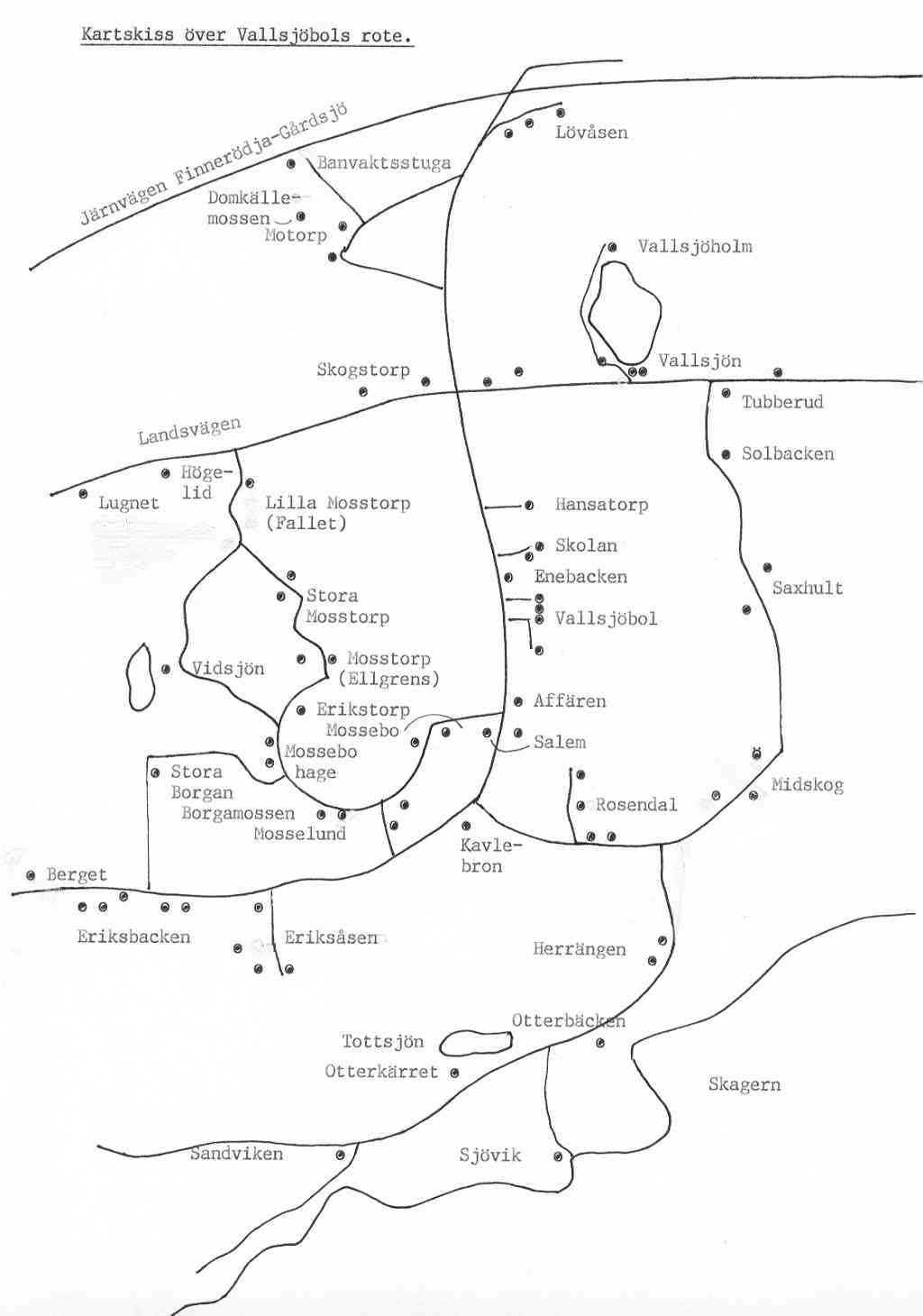
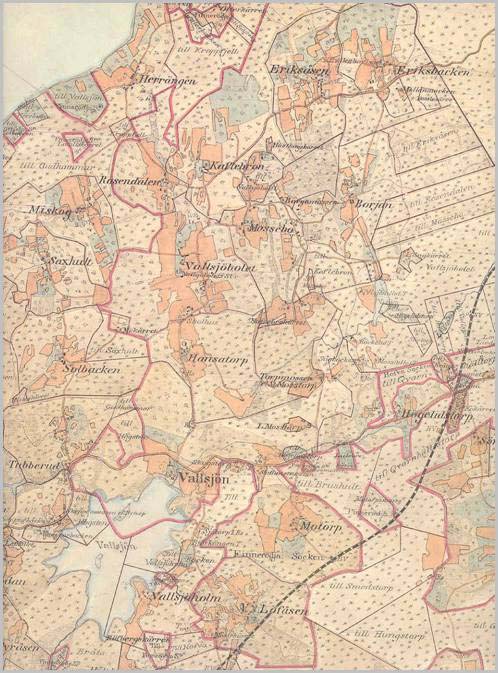
FOREWORD.
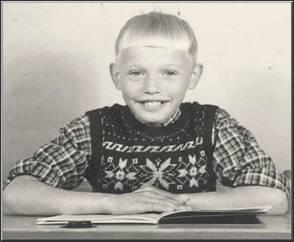 |
I have written this account as if it were 1948. Most of it is true and happened. Some did not happen. Some might have happened. It tries to describe the times as viewed with the mind and comprehension of an 11-year-old. This means that associations move swiftly between one thing and another. I use short, simple sentences and many repetitions. I have not tried to reproduce the dialect. I have not researched any of the material. All is collected from memory and, in some amount, fantasy.
After all these years, one or another error is inevitable. I wrote this during 10 days in January, 1995.
My name is Alf and I live in Vallsjöbol. Vallsjöbol
is a
village in northern Västergötland. It is near Lake Skagern.
There are 6 of us. If you count maternal grandma and Adel, there are 8.
My mama is Birgit and my papa is Gunnar. I usually call them Morsan
and
Farsan4. Bernt is my brother and he is 2 years older
than me. Britt and
Barbro are my sisters. Mama and Papa are named Carlsson, and we are
named Gunnarsson.
When Barbro was born, I thought she was unnecessary. I no longer think
that. Barbro is 8. Bernt is 13 and Britt is 9. I am 11.
There are 2 houses on our farm. Mama and Papa and the children live in the big house. Grandma and Great Uncle (maternal grandfather's brother) Adel live in the small house. Bernt and I usually sleep in the small house. But our Vallsjöbol is not the real Vallsjöbol. It is not connected to the other Vallsjöbol. We are nearer to both Kavlebron and Mossebo. It is not far to Mosselund and Borgamossen, either.
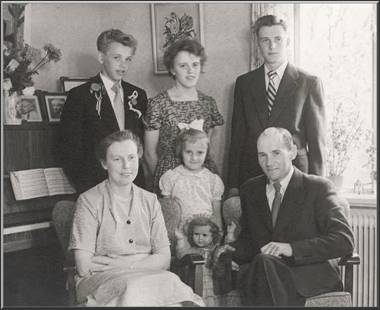 |
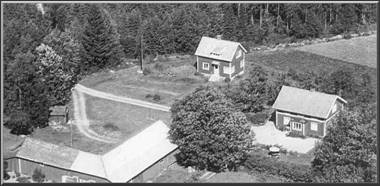 |
| Family Portrait, 1954 Back Row (L-R): Alf, Britt, Bernt. Front Row: Birgit, Barbro, Gunnar |
Vallsjöbol 1:8 |
[Footnote 4: I don't know how to translate this, and neither does Alf. He says it was a common form of address to one's parents in the 1940s, but less so now.]
My paternal grandfather lives in Mossebo and he is named Karl. Karl Andersson of Mossebo. Papa was born in Mossebo and so were all of his ancestors. It takes only 5 minutes to walk to Mossebo. When papa speaks of Grandfather, he calls him farsgubben5. I have never met my paternal grandmother. She died when Papa was little. I have only seen her picture on a card. I can barely remember someone in that way.
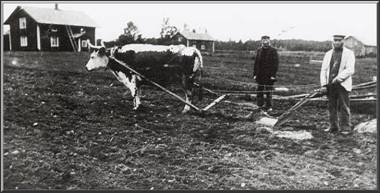 |
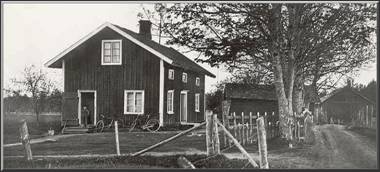 |
| Alf's father's mother's father plowing at Mossebo, circa 1900 |
Mossebo in the 1930s |
Elsa replaces Grandmother. She met Grandfather long before I was born. Lennart is Elsa's and Grandfather's son. He is 19 and has a motorcycle. It is a BSA. He talks about exchanging it for a Harley-Davidson. He has a license and will soon be in the military. I think he's a little stuck-up about his license. I have never called him Uncle Lennart. Bernt and I sometimes play cards with Lennart. It was he who taught us how to play. Mama does not like it when we play cards. We do not have cards at home. A pack of cards is kept in the attic in Mossebo. There we often sit and play Five-Card and Redbeard. If we sit too long, Grandfather knocks with his cane on the ceiling. Then it's time to go home.
[Footnote 5: Elmer Lofgren (my dad) also referred to his father as farsgubben, although not when grandpa was within hearing distance. He said it means "foreman," but that doesn't sound quite right, as it seems to combine far="father" with gubben="old man." I couldn't find it in any Swedish-English dictionary.]Some people named Stoltz once lived at our place. That is a strange
name. I hardly know how to spell it. Grandfather always says we live on
Stoltz's. "Stoltz's" is a nickname. Mama doesn't like nicknames. Cards
and nicknames: two things Mama doesn't approve of. They are ugly. Dumb
and unnecessary and ugly -- and that's that!
"Stoltz's, no, I won't hear
of it," she says. In our home, no one says "Stoltz's."
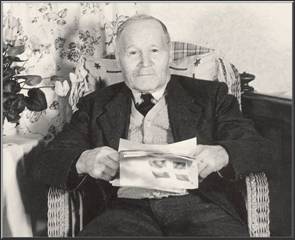 |
"The Stoltz spooks are near," Grandfather sometimes says.
That was before Mama told Papa, "Tell your father to stop talking
nonsense."
"It is enough to have seen both one and the other," said Grandfather.
Then he would wrinkle his eyebrows and look grave. He spoke of many
inexplicable things. Inexplicable and supernatural occurrences with
Stoltzes. I don't really believe in spooks. But you do notice tension
and a little gloom. It must have happened a long time ago, I think. But
hadn't Grandfather seen it with his own eyes? Maybe he made a mistake,
I think. Maybe he forgot to put on his eyeglasses.
Mama doesn't believe in spooks. "Such talk is nothing to fool with,"
she says.
One time I tried to joke with her. "I saw a spook in the house," I said.
"Oh, phoo! I don't believe that. What was it?"
"It was Greta of Röfors," I said.
"No, that's going too far. She's a spook?" said Mama.
"I don't know," I answered. "You were the one who said that."
"I don't understand this one bit," said Mama.
"Don't you remember Greta of Röfors, who came bicycling by
one day
last spring? She wore a big black raincoat. When she came into the
kitchen, you said to her, 'Now I think I've seen a spook in broad
daylight.' That spook was just like Stoltzes," I said. Mama had nothing
more to add.
No one calls him by his real name, Adolf. Everyone says "Adel." I have never heard Adel talk on the telephone. There is only one telephone at our place. It's on the wall in the big house. It is Kavlebron 9. We have not had the telephone very long. No one in the area had a telephone earlier, but almost everyone got a telephone at the same time. The telephone exchange is at the Sahlens. Allan Sahlen has the store in Vallsjöbol. It is really the city center. Mrs. Sahlen is named Ingrid. They have no children, but they do have a peacock. It's not for sale. The telephone exchange is not named Vallsjöbol. There is already an exchange with almost the same name: Valsjöbyn in Jämtland! "It could be misunderstood," said the man at the telephone-works. Kavlebron is a good name for the exchange. Nothing is similar to Kavlebron. As you say, so you are, as Adel often says.
No one ever rings for Adel. I think it would be fun if someone did. Then I would run to him and say, "Hurry and come, Adel! The telephone is for you." Then I would try to listen to the conversation. Adel speaks softly and slowly, thinking about each word before he uses it. I don't think he understands the telephone. It's easy to sit at the kitchen table and talk, to speak of both this and that. But on the telephone, you must be more straightforward. No, Adel has never been a telephone talker. And he won't become one, either.
Three years ago, a moving van arrived from Barrud. Grandma and grandpa6 and Adel moved into the little house. It was newly built then. Grandpa died the next year. That was the first time I'd been to a funeral. Everything was black and sad in the middle of the summer. All the men wore black clothes. And all, without an exception, had black shoes. Afterwards, we ate at Davidsson's hotel. That was the first time I ate ice cream. I was greatly surprised when I tasted the first spoonful. It was homemade strawberry ice cream. Food and strawberry ice cream at Davidsson's hotel. I remember that best about Grandpa's funeral.
Now grandma and Adel live in the other house. Adel sleeps in the bedroom and grandma in the kitchen. That's practical, for grandma tends the stove. She cooks coffee and makes food for herself and Adel. Adel works from morning until night. He cuts wood and helps in the cowbarn. He works in the fields and repairs something if it's broken. It's nothing for him to sit with his arms folded. Just as often, he sits with his hands clasped. He always does that when he listens to devotions on the radio. You cannot talk to Adel then.
The most interesting thing about Adel is that he has traveled. He went to America when he was young . He was uncomfortable there, so he came back to Sweden. I think it's almost the same case now. Sometimes Adel seems like he's homesick. Homesick for Barrud!
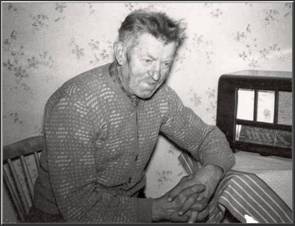 |
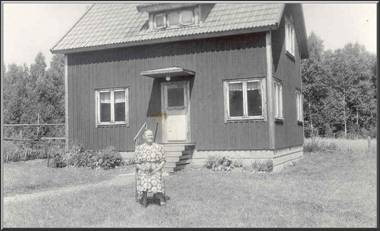 |
| Adel (Per Adolf Carlsson) at the radio | Alf's maternal grandma in front of the little house at Vallsjöbol |
[Footnote 6: I use "Grandma" and "Grandpa" to refer to Alf's maternal grandparents, and "grandfather" to refer to his father's father. This is not necessary in Sweden, where they would be called mormor and morfar (mother's mother, mother's father) to distinguish them from farfar.
Mama respects Adel for many things. She most respects that he was a Sunday School teacher. That was in Barrud, when Mama was little. I've gone to Sunday School for many years. Bernt and Britt have gone, too. Bernt is almost done with it. He will soon go and study with the preacher instead7.
The preacher is named Johnsson. Rector Hugo Johnsson of Finnerödja. He lives alone, with a housekeeper, in a large parsonage. His wife lives in Stockholm and she does not come to Finnerödja often. She only comes for the Christmas Morning Service. She sits in the front row in church and wears a fur coat. Then people peek a little extra and whisper in the pews, "Yes indeed. Yes. Yes. I should say so!"
Our Sunday School is in the Mosselund Mission House. It takes only 5 minutes to get there from our place. That's good. On the first Sunday in March, it is extra good. That's when the Vasaloppet report is on the radio. We don't miss that. You want to know the standings in Evertsberg before Sunday School. Mora-Nisse won again this year8.
The usual Sunday School teachers are Johan and Axel. Johan of Borga and Axel of Eriksbacken. Johan of Borga is big and loud and strict. Axel of Eriksbacken is small and quiet and nice. Johan of Borga sounds like thunder, while Axel of Eriksbacken whispers. When Johan sings, the roofs in Mosselund are stressed. We are related to Johan of Borga. He is Papa's maternal uncle. But I don't think I'm very much of a relative of his. He is way too strict to be my relative. Axel of Eriksbacken usually has a surprise in his back pocket. The surprise is always a bag of Polish-Pig candy9. He gives them out at the ending of Sunday School.
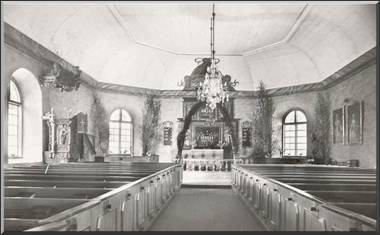 |
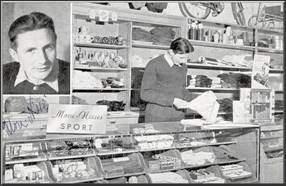 |
| Finnerödja Church interior | Mora-Nisse |
[Footnote 7: In the Harris Lutheran Church, we'd call that "confirmation class."]
[Footnote 8: Mora-Nisse refers to Nils Karlsson (Nisse is a nickname for Nils), who lived in Mora and won the race for many years in a row in the 1940s. According to Alf (as of 2004), Mora-Nisse is still alive, but in his 90s and confined to a wheelchair.]
[Footnote 9: Alf says this is "a kind of candy, white and red and very sweet."]
There's a mission auction twice a year. Johan of Borga is the leader. He preaches, he holds the auction, and he sings loudest of all. Many people attend the mission auction. Almost everyone comes. Most do not come until the preaching is over. It is festive with all the people and all the things to sell. They serve coffee and cake and tarts and juice. Cream tarts with raspberry jam! There is much munching in Mosselund.
I especially remember one mission auction. Bernt and I got spankings when we got home. Mama said we had behaved badly. We had not sat still and quiet at the table. Papa carried out the punishment. I don't think we've been spanked since then, at least not after a mission auction.
But now I remember another time when I was spanked. I was mad and called Papa an old man. "You are a real old geezer," I yelled at him. He laid me across his knee and spanked me. I tried to explain. "But you call grandpa farsgubben." That didn't work because he didn't understand what I meant. Maybe he got mad about the "geezer" part. Or else he wasn't listening to me.
Mama says children must learn politeness. All this time, Bernt sat on a kitchen chair with his schoolbooks. He looked up, looking like a rascal, when he said, "Honor thy father and mother, Alf," and, after a pause, "for that way you will do well and escape beatings."
Thus ended the punishment.
I go to the Vallsjöbol school. Bernt and Britt go there, too. Bernt is in sixth grade and has only one classmate. Sixth is not a large class. The entire class sits on one bench. I'm in fourth grade, and there are 5 of us. Our class fits on 3 benches. Britt is in the second grade, and she has 11 classmates. That is the largest class anyone can remember. Six full benches for the second grade. All three classes sit in the same schoolroom. And all have the same teacher, who teaches all three classes at once. Vallsjöbol is a B-3 school. The lone teacher at Vallsjöbol is named Gustaf Nilsson. Elementary Teacher Gustaf Nillson, he's our schoolmaster. I once dispensed with titles when speaking to Gustaf Nilsson . That was when he came to Vallsjöbol in 1943. I had not started school then. I didn't understand that I couldn't say du to him10.
Papa is commissioner for the Vallsjöbol district. He
regulates the
practical affairs of the school. He gets wood for the school. He
varnishes the floor before the term begins. Papa is a member of the
school board, too. I have no idea what the school board does. Gustaf
Nilsson was new and unknown in the district. The Commissioner brought
the schoolmaster home for evening coffee. That was before
Märta11 had come to Vallsjöbol.
Schoolmaster Nilsson came
and drank coffee and talked. Mama and Papa called him mostly "Nilsson."
He called them "Mr. Carlsson" and "Mrs. Carlsson." We had got a Fortuna
game for Christmas that year. We ventured to challenge the schoolmaster
to play the game. He had never played Fortuna before. I was so
comfortable with the game that I forgot all manners.
"Now, du schoolmaster—now du will get to see
schoolmastering!"
and
"Now du will get a beating, schoolmaster!"
Mama asked him to excuse the ill-mannered child. The next year I
started first grade at the school. Then I was no longer on du
terms
with the schoolmaster.
[Footnote 10: Swedish has both a formal and informal version of "you." When speaking to strangers or people in authority, you must use ni (pronounced "nee"). When speaking with friends or equals, you use du (pronounced "dew").]
[Footnote 11: Märta was the schoolmaster's wife.]
When papa was little, he also went to Vallsjöbol school. His teacher was named Anna Gunnarsson. She's retired now and lives with her sister Stina in Gårdsjö. They live in a little gloomy house almost on the road. Mama points out the house when we drive by. "There lives Anna Gunnarsson, Papa's teacher," she says.
I think it's funny that she's named "Gunnarsson." I don't know very many with that name, except Bernt and Britt and Barbro, of course. Mama does not know Anna Gunnarsson well. We never stop by and say hello to her. Papa doesn't try to meet her either. He doesn't spend a lot of time thinking about where his teacher lives. He never points at the house in Gårdsjö and says "See there. My old teacher, Anna Gunnarsson, lives there." He seldom points at anything. He lets Mama take care of such things.
Between Gårdsjö and Smedsbol is a little narrow pond. Bernt has sometimes fished in that pond. It's in either Narven or Gårdsjön, I don't know exactly. When we drive by there, Mama points at a house. "That's the Gårdsjö Kvarn," says Mama. "My mother went to school there when she was little."
Bernt talks at the same time about all the fish he caught.
"She walked from Smedsbol," says Mama. "That was then, though. (sigh)."
We seldom drive to Barrud. The farm at Barrud is
rented out now . Adel
Eriksson and his wife Anna use it. They took over when Grandpa and
Grandma moved to Vallsjöbol. In the summer we sometimes
drive
anyway to Lake Unden. We drive to a bathing beach named Ullsand.
The
beach is at least a kilometer long, but there are frightfully many pine
needles in the sand. Pine needles are sharp and sticky on the soles of
your feet. That's bad when you've just bathed. There are no pine
needles at the Otterbäcken beach. Otterbäcken
is on Lake
Skagern and we bathe there often. The only dumb thing about
Otterbäcken is Herräng's hill. It's so steep
and hard to
climb that you're all sweaty when you come home from bathing.
When we drive to Ullsand, we pass by Ullsandsmo. It's
just before you
get to the beach. There is a house there that warms Mama's heart. She
has much to say when we drive by there. The house is her old school.
She always speaks well of her teacher, Mrs. Mikaelsson. Mrs. Mikaelsson
is retired and lives in Finnerödja now. We visited her
once. She
and Mama talked the entire time. "It was so much fun to talk over old
memories," said Mama. Mrs. Mikaelsson once had a famous student in her
class. That was when she taught in Blekinge. The student was
Harry
Martinsson12. He wasn't famous then, you understand. But
nowadays,
everyone knows who Harry Martinsson is. I think that somewhat
remarkable. Mama and Harry Martinsson had the same teacher.
[Footnote 12: Harry Martinsson (1904-1978) was a much-beloved Swedish poet who won the Nobel prize for literature in 1974.]
Mama's school is closed down now, and so is grandma's school. But in
Vallsjöbol, school is going full speed. There are 5
students in
our class. There were 6, but Tuve has left. He and his older brother
Leif lived in a railroad lineman's cabin. The cabin is at Motorp.
That's on the railway line between Finnerödja and
Gårdsjö. Now their papa has been moved to Dalarna.
Actually,
they first moved to Moholm. But that's another story.
Leif and Tuve did not talk like us. They spoke Dalarna dialect,
and
that sounded almost like singing. It was a strange song they sang. It
was hard at first to understand what they were talking about. Once Mama
and I met Leif's and Tuve's aunt. She was like a mother to them, since
their mother was dead. We met the mother-aunt on the road near
Kavlebron. Mama got off her bicycle, reached out her hand and
said,
"Hello. How are you?"
Aunt Axelsson's answer was quite unusual: "Ah! Aye dunno how ay've
been. Ay've been so troublesome13."
"What did she say, anyway?" I asked after we left.
"That requires some thought," said Mama.
Anyway, I thought the sound was funny. And Mama thought it was funny, too, for she often repeated it.
Tuve was my pal and benchmate in school. We played together a lot until he moved away. Often Bernt and Tuve's brother Leif were also along. Leif was a regular adventurer. He often wore a black slouch hat, and a sheath knife hung from his belt. I wondered if he'd borrowed the hat from his father. But, no, it was his own hat. He was big and strong and almost dangerous. Black hat and sheath knife!
[Footnote 13: There are a lot of different accents in Sweden, some of them mutually non-understandable. I tried to get across the exotic feel of the accent here. It is of course untranslatable into English.]
Sometimes we bicycled to see Leif and Tuve. They lived in the smallest house I've ever seen. One gable faced the railroad tracks. There were no more than a couple of meters between the house and the tracks. All the cookware rattled when a train thundered by. It was dreadfully noisy. Leif's adventure urges took various expressions. Sometimes he borrowed his papa's tramp-cart without permission. He'd lift it up on the rails and tramp a little. To ride the cart without knowing if a train was coming was hugely dangerous. Trains are not something to play with. Leif says they go 100 kilometers per hour. But Leif liked to challenge fate. Also, he had a trick for hearing when a train was coming. He'd learned it from his papa. You lay an ear against a rail and listen. Leif laid an ear against a rail and said, "A train from Gårdsjö is coming soon." Then he took a two-öre piece14 and placed it on the track. When the train came close, we ran into the woods and hid. We sat very still behind some bushes. When the train had passed, we ran up on the tracks again. The two-öre piece was flattened out to be as big as a five-öre piece. Leif was not at all surprised. Leif thought up amusements like that. There were many warnings when we came into the house. Aunt Axelsson sang them out regularly. Only Leif and Tuve understood what she said.
I don't think Leif enjoyed school. He often sat idly and looked out the window. When the schoolmaster noticed, he'd say, "Leif will not sit there and dream! Hup!" Leif would obey and start to do arithmetic or writing for awhile. But it would not be long before he was dreaming again.
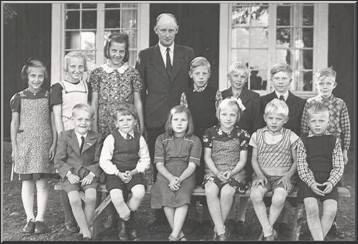
On Saturdays we have a good time. Then the schoolmaster isn't as rigid about what we do. It's good to have fun, I think, for we don't have fun very often. The schoolmaster has us sit in the schoolroom. If we were to decide for ourselves, we would go outside to play brännboll15 for a joyful hour. But now there's mostly reading and singing. One time we guessed riddles. The schoolmaster read riddles out of a book for us to guess. He had no hard puzzles in his book.
We're able to suggest songs we'd like to sing for fun time.
Leif had a
favorite song about a Viking:
Now I've set out upon the stormy sea.
Leif didn't sing much, but he read the text. I think he dreamed that he
was along on the Viking journey. Leif also had a favorite poem:
King
Karl, the young hero, stood in the smoke and dust.
When we read that,
he also dreamed. He would have wanted to be in Karl XII's war, too16.
Viking travels and war. That was the span of things that interested
Leif.
[Footnote 14: An öre would have about the same value to a Swede as a US penny would have to us.]
[Footnote 15: Literally, brännboll ="burnball." Alf says it's something like cricket, involving a bat and a small ball. If you don't run fast enough between bases, you get "burned."]
[Footnote 16: Karl XII (1682-1718) became king of Sweden at age 15. He was big on troop morale, so led them into battle. He won a big fight with the Russians, but then lost a big one in 1709. Addicted to war, he traveled around Turkey trying to get them to fight the Russians. He finally went to Norway, led his troops into battle, where he was shot and killed. Nowadays, kings and presidents have enough sense to leave troop morale up to the field commanders.]
At first I thought it was dull after Tuve left. He and I sat on the same school-bench. It felt empty when he was no longer sitting there. We wrote a couple of letters and an occasional Christmas card. Then the exchange stopped. Now we are an uneven number in class. There are 5 students to sit at 3 benches. Someone must sit alone. Gunborg sits alone at her bench, the furthest back. In the middle bench are Majlis and Hasse. Eldroy and I sit on the front bench. Hasse does not think it's fun to sit next to a girl. You can't whisper to a giggling girl. The schoolmaster determines where we sit. We have to sit where he says.
The schoolmaster rules Vallsjöbol school. Or more correctly, the schoolmaster rules the schoolroom. In other areas, Märta has some say, also. We don't really know what we should call Märta. Girls who have her for handiwork and homemaking call her "Miss Märta." Boys usually call her "Aunt Märta." "The schoolmaster and Aunt Märta" is what we say.
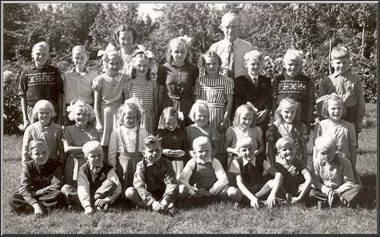
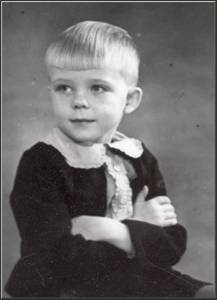 |
Last winter, we were skating on Tott's pond on a Sunday. We also played bandy. When we were almost done, Bengt Öh came bicycling. He had no skates with him, so he watched awhile. Then we talked on the shore. We had bicycled through the woods, but Bengt bicycled on the ice. It was slippery, so it was not an easy thing to do. Bengt performed a real balancing act. Suddenly he sank straight through the ice on his bicycle. A brook ran out there and it was quite shallow. But still, we saw only the seat and handlebars of the bicycle, as well as the upper part of Bengt. Everything else was under water. Bengt, on top of his bicycle, looked surprised. Then he splashed his way out. We shivered just to look at him. He was mud-soaked with water running off him. Bengt didn't say a word. He didn't even say "hey, then" when he pedaled away.
Bernt Schill was making a footscraper in woodworking class. His
carpentry was finished. It only remained to waterproof it. "Go out and
paint on the stairs," said the schoolmaster. Bernt took a brush and can
of colored waterproofing and disappeared. After awhile the schoolmaster
went outside to see how the work was going. When he opened the door, he
got a shock. Bernt had painted the cement steps green. "What are you
doing, dummy?" asked the schoolmaster.
Bernt, surprised, said, "I did exactly what the schoolmaster ordered."
The schoolmaster didn't know whether to laugh or cry, but he settled on
laughing. Soon all the students admired Bernt's artwork. The cement
steps were as green as a lawn.
Sunday School is held in Mosselund, in the Mission Hall. But there's also a Pentecostal Hall. Their chapel is across from the Vallsjöbol store. There are often meetings there. The Children's Meeting is held Saturday afternoon in that chapel. The pastor comes bicycling from Gårdsjö. The pastor sits at a little table in front, in a little room. The children sit on benches. We go to the Children's Meeting only sometimes. It's about the same as Sunday School, but things are a little more lively in the chapel. Sometimes Lilly of Herrängen comes with her accordion. Then it becomes even more lively. Other times, someone plays the organ. Almost no one plays during Sunday School. Johan of Borga has fingers that are too fat for organ playing. They take collection, both in Mosselund and in the chapel. The money goes for good deeds. At the Children's Meeting, the collection is put in a box with a negro on it. The shy negro boy bows if you put a coin in the box. That means he thanks you for the contribution.
In Mosselund, there's no negro boy who bows and thanks. There are only Johan of Borga and Axel of Eriksbacken who thank, but neither of them bow.
Sometimes some missionaries come to the chapel and speak. They usually show slides also. One time we heard a man from India was coming. We thought we were going to see a real Indian. It was a huge disappointment. He had no feathers on his head. He looked like the negro boy on the collection box, but he was bigger and did not have curly hair. The Indian spoke only some foreign language, so the missionary had to translate. "It was very nice to come here," he said. At least, the missionary translated it that way. So that was that with the Indian adventure. People from India are neither Red Indians nor negroes. Real negroes live in Africa. Most of the collection goes there. There are missionaries in Africa, and they need money to convert the negroes. We have an engraving at school with negroes on it. It shows that it is hot and beautiful in the sun. They lie outstretched against some tree trunks and eat bananas. "But they are primitive folk," says the schoolmaster. "Negroes are primitive and undeveloped," he says. "They must be directed by civilized lands, for their own sake."
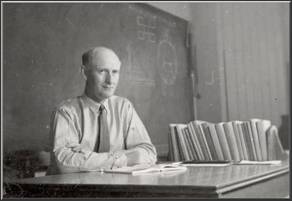 |
It could be that negroes are uncivilized. But the most uncivilized are certainly those in New Guinea. There people eat each other up. We heard that on the school radio. Sten Bergman told this story. He is not a missionary. Sten Bergman is an explorer. When he comes back from a journey, he has much to tell. He lectures on the school radio. Now he's come home from New Guinea. It's lucky he wasn't eaten, for then he wouldn't have half as much to say. It's thrilling to listen to Sten Bergman. "Sten Bergman is an extraordinarily interesting person," says the schoolmaster. Märta thinks so, too. She also listens to Sten Bergman on the school radio. She can listen in the kitchen, thanks to the schoolmaster's cleverness. He ran an extension between the schoolroom and the kitchen. There's a loudspeaker in the kitchen. Märta can prepare food and dishes and listen to the school radio at the same time.
One time the schoolmaster forgot there was a school radio program. Or
maybe he thought it was unnecessary to listen to it. It was a program
that interested Märta, though. She came into the schoolroom in the
middle of a lesson and said, "Gustaf, have you forgotten the school
radio?"
The schoolmaster turned a little to the school radio receiver and
answered, "No, I have not forgotten, but we have other things to do
today."
Märta looked disappointed as she turned to go back. The
schoolmaster went and turned on the radio. But he closed the door to
the closet where the radio was. In the schoolroom we heard almost
nothing from the radio, at least not after the lesson started again.
But Märta could listen on her loudspeaker in the kitchen. I don't
know what program we missed.
So it goes when the door is closed.
I have no first cousins. Mama has no siblings, so that explains much. Papa has but two living siblings: Uncle Gustaf and Aunt Mildred. Gustaf lives in Karlskoga and is not married to Ingeborg. They are engaged and live in an HSB apartment17 There are only two rooms and kitchenette, so there's no room for children. Mildred lives in Örebro and she is neither married nor engaged. She has a cafe on Drottninggatan 18 in Örebro.
Mama has lots of cousins. So does Papa. Many of Mama's cousins live in America. Papa's cousins live in Sweden. Mama has cousins in Smedsbol and Pjungserud and Stockholm. Papa has cousins in Hova and Rävlanda and Borås. Some are almost neighbors. Then there are cousins in Göteborg and Kristinehamn. We have never met Mama's cousins in America, but Mama exchanges letters with them sometimes.
Sometimes cousins come to visit. Daniel of Borås and Lea
have
visited a few times. They have three children, and they don't behave
like other children. They do not say du to their parents. It
sounds
strange when they talk that way to their mama and papa.
"Will father help me to open the car door?" is what they say.
"Can mother tell me the name of that bird?"
Daniel Jagner is an engineer.
It's no doubt fine to speak to each other in that manner, but it sounds strange to my ears.
Daniel is the brother of Mattis, who is married to Axel. They live in Struppkärr. There are two sisters who are daughters of (paternal) grandfather's sister. One of them is named Stina and she is a schoolmistress. The other sister is also a schoolmistress and she's named Elsa. Pelle of Struppkärr is the son of Mattis and Axel. His brother is named Lars and they also have a little sister. She is named Margareta.But that's beside the point. I should say something about Pelle of
Struppkärr. His mama told it once. Pelle's aunt was
schoolmistress
in Hova and Pelle was in her class. He was a little lazy, and
his aunt
didn't approve of that. They had arithmetic, and after a whole lesson,
Pelle's workbook was blank.
"It's been a whole hour," said his aunt. "And Pelle has not finished a
single problem," she continued.
"Yes, time goes by," answered Pelle.
His mama thought that was an inventive answer.
Bernt and Alf and Britt and Barbro have no first cousins. We have too many second cousins to count. But second cousins are pretty distant relatives. We know most of them, but not all.
Now I remember another thing. Aunt Mildred's cafe in Örebro is called Hansa. But that has nothing to do with my cousins or second cousins. She used to have a radio-phonograph in her cafe. It had an automatic record player. It played 10 disks in a stack. But that has nothing to do with my cousins or second cousins either. Now we'll speak of something else.
[Footnote 17: A co-operative apartment. Alf doesn't remember what the initials meant.]
[Footnote 18: Drottninggatan ="Queen Street."]
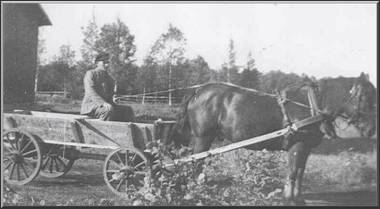 |
Summer break is beautiful. When school ends in June, we have many weeks off. Fall term doesn't begin until the end of August. We help at home during summer break. Sometimes there's time to ride and swim, but it's mostly work. We have to get up at 7:00 in the morning. Papa has been up at least an hour by then, and Adel has been up for two hours. Grandma has also been up that long. Mama has already made breakfast by 7:00. Usually it is oatmeal and milk and bread and butter. Grandma makes food for herself and Adel. They also eat oatmeal.
Papa has been to the cowbarn and milked the cows. Adel has helped him. there are 5 cows to milk. Adel milks 2 cows and Papa milks 3. "Adel is not a mas," says Papa. At first I didn't know what he meant by that. I knew that a mas was someone who lived in Dalarna. It's short for Dalmas. But it goes without saying that Adel is not a Dalmas. He could just as well say, "Adel is not a Smålänning." But Papa never says that. Now I realize that Papa compliments Adel when he says that. He means Adel is a genuine worker.
Milking is finished now. The cows don't get any food besides grain in the cowbarn. They get the rest when they're let out to pasture. It's the same way with the horse. He has food in a rack over in the horsebarn. The milk is put into large milkcans which are shipped to the dairy. The dairy is in Hova. But one must be careful with cleanliness. Otherwise the milk will sour and then there will be penalties and deductions.
The hens need food and snail shells. Otherwise they won't lay eggs. The rooster also needs food, but he won't lay eggs anyway. The pig lives his whole life in a pen in the cowbarn. We feed him on swill and whey and all sorts of things.
At 8:00, the milk cans are on the milk table by the road. The milk truck comes and takes them. The milk truck's bed is entirely filled with milkcans. In the afternoon, it comes back with the cans. They are empty or else filled with skim-milk and whey. You can buy cheese and butter from the dairy. They bring that with the returned cans in the afternoon.
There is much to do in the summer. Hay to be cut and put on the hay wagon and driven in. Potato land to prepare. Strawberry land to be set and weeded and mulched and harvested. And weeded and weeded and weeded. It goes endlessly, from morning to evening, every day. If you oversleep, they get mad. Then you have to hear that you're a real sluggard.
One time Adel came and woke me at 9:00 in the morning. He stood at the
steps and cried, "Hello! Hello! The sun is high in the sky and the
horses have been out in the meadow for a long time."
I looked and saw that Adel wore a newly-washed blue shirt. Then I
remembered that it was Sunday. Besides, it was gray and cloudy out.
"You're lying to me, Adel," I said.
"You're only a slug-a-bed, anyway," said Adel. "I won't waste the whole
day while you sleep."
Maybe he was right. In some way.
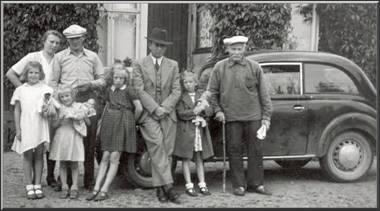 |
Many think cars are a great invention. It is a flexible way to travel. Think about when you want to go to church on Sunday. It takes only a quarter of an hour if the roads are good.
We have a Renault. It is a French car, pronounced "Ren-oh." I don't know of anyone else who has a black Renault. French is a peculiar language. The three first letters in "Renault" are pronounced in the same way as Swedish. But the last four letters could be replaced by only "å."
Before we had a car, we had to ride on horse and wagon. There were also bicycles, of course. In the winter, horse and sleigh. I rode the sleigh with Grandfather once when I was little. He needed to pick up something from the train at Gårdsjö. There was a lot of snow on the road. There was little difference between road and ditch. And it was also dark. The carbide lantern on the sleigh gave little light. The horse had bells on its neck. The bells rang softly when the horse walked and were louder when it trotted. The sleigh overturned in a snowdrift. Both Grandfather and I fell off the sleigh. "Whoa," said Grandfather, and the horse stopped. Soon we righted the sleigh and started out again in the dark.
Nowadays there's no problem in going to Gårdsjö. It
takes
less than a quarter hour by car. Horse and sleigh took almost a whole
hour. Especially if the sleigh tipped over on the way.
Sometimes we drive to Karlskoga and Örebro. And Töreboda
and
Mariestad and Hova are not far away. Once a year we go
to
Skånings Åsaka. That's not too far from Skara.
David and
Eva and their girls, Birgit and Astrid, live there. We aren't related
to them. Mama and Eva know each other from long ago. They went to
homemaking school in Axvall when they were young. If we don't
go there,
they come here instead. Then they usually stay two or three days.
Before they come, there is much activity. Everything must be neat and
fine, both inside and out. It's a huge schå19.
I wonder how
schå is spelled in French? Maybe Schault?
Then the friends from Skara arrive. They have a huge black car,
a
Chevrolet. David doesn't have a license, so Eva always drives. The
girls sit in the back seat. Now there's a huge Chevrolet and a little
Renault in the yard.
"Hello, hello, how are you? And welcome."
"Thanks, thanks, yes, we're well."
Then there are food and excursions throughout the day. Papa and David
take midday naps, but that doesn't slow down Mama and Eva. They have
much to tell each other. And they take photographs -- all of them taken
in
front of the cars.
Suddenly, it's time to leave again.
"Goodbye, goodbye, and we hope the trip goes well." All talk at once on
the veranda.
"Now drive carefully," (unnecessary reminder). "And welcome back."
David sticks his head out the front window. He looks at Mama and says
to Papa, "It was fun when we came, but more fun when we leave."
Then they go away to Skånings Åsaka at an easygoing
pace.
"Cars are a blessing," says Mama.
On Sundays we sometimes get car-visitors. Often it is Uno and Aina from Degerfors. They aren't relatives, only acquaintances. Uno has a bicycle business and workshop in Degerfors. He's a driving instructor, too. His car is funny, for it has dual controls. It has a clutch and brake besides those on the driver's side. He can help with the braking if he needs to. But there's only one steering wheel, so some aim is required.
When Uno and Aina come, there's a good lunch. Papa goes to the cellar and gets several canned preserves. An hour later, Mama has the food ready. By the time everyone's done eating, it's time for them to go home again. And so goes another Sunday.
One Sunday set a record for car visits. That's what Adel thought, anyway. First a car came in the forenoon. Later in the day, another one arrived. In the afternoon, another one. Adel could hold back no longer. He came in the kitchen and said, "Today's a day when everything's going wrong." Adel did not think cars were a blessing. At least not on Sunday. As you say, so you are.
[Footnote 19: schå (pronounced "show" = "chore."]
One evening every autumn, the house exam is held at Vallsjöbol school. The Rector and Olle of Bråten come in a car. The preacher usually bicycles, but today he gets a ride. He has two large books under his arms. The books are so big there is no room for them in his briefcase. There he brings a bible and a psalmbook. It begins with a hymn and a short sermon. He can talk for an hour if he feels like it. But today it will be only a short sermon, he says. So he's finished in only half an hour.
Now the Rector says "amen," and the house exam can begin. The house exam is an old tradition that lives on. Once it was a real examination. Back then, the preacher determined who knew their bible and catechism books. But that's no longer the case. Now it's just about who lives where. Tonight we're going through the Vallsjöbol district. If you counted it up, there would be an awful lot of names. The Rector, wearing a black cap, sits at the head table. Olle of Bråten sits beside him and takes notes. The schoolmaster has a subsidiary role this time. On the table are the two large books, opened. It rains and blows outside. Inside, it's as warm as a Turkish bath. No one thinks of opening a window.
Every farm has a name and a number. We live on Vallsjöbol 1:8. A long and monotonous procedure begins. Farm after farm after farm is called.
A red-cheeked girl raised her hand and said, "Yes, Asta, my big sister,
has moved."
"She has moved?" asked the Rector, surprised.
"Yes, she's moved to Finnerödja."
"But, dear child, she already lived in Finnerödja parish."
Then the red-cheeked girl said something to show she knew the
difference between out and in. "You can't move to a place where you
already live."
Now Olle from Bråten tried to help.
"Yes, Rector. She may have moved inside the community, but she still
has a place in the family, even so."
"Yes, yes," said the Rector absentmindedly. "That is indeed possible."
So sometimes there are matters to be discussed. But mostly things move along smoothly. The Rector is contented if he's not disturbed. He wants to read a little without interruption. He likes preaching better than conducting the house exam. When preaching, he won't be disturbed, anyway.
At the end, the Rector closes the books and claps his hands. Olle of Bråten lays down his pen and folds his arms. Then the preacher rises. And he proposes a rousing cheer for Vallsjöbol.
No, I'm only kidding. The Rector rises and reads the benediction and says, "Now we will end with the singing of the hymn, 'A Mighty Fortress Is Our God', first verse." You hear only the Rector's voice in the singing.
The house exam is over. The only problem is to wonder whether Asta has moved or not. If I understand it right, she has both moved and not moved. The question is a real puzzle. But maybe it isn't important to solve problems like that.
In the changing-room, the Rector spoke to Asta's sister. "And now, are
you going to move to Finnerödja, little one?" The Rector
laughed
in a friendly way as he put on his galoshes.
Asta's little sister lowered her eyes, curtseyed, and said, "I've
already done that, as soon as I'm home."
The preacher took his books under his arm and mumbled, "Yes, yes,
that's good. Good luck, good luck."
Olle from Bråten had already started his black Volvo.
They drove
back down the Eneback hill.
Not everyone comes to the house exam. Think what would happen if they did. The schoolroom would not be big enough. You'd have to borrow the Mosselund mission house. Or maybe the Salem chapel. They have extra stools if the benches are filled. All those people could be handled in this way, if they all came at once. And it would be needed if they came. Vallsjöbol district stretches all the way to Lövåsen. That's several kilometers.
LÖVÅSEN.
I don't know very many in Lövåsen. Britt has an
acquaintance, a classmate who lives somewhere there. I think so,
anyway. Her name is Gunnel. Her mama is named Mrs. Dahlbäck. I've
not heard anything about a Mr. Dahlbäck. I think they're from
Lappland. Also, we have Olle of Lövåsen, of course.
And I
think there's also a Gunnar of Lövåsen. Anyway, Olle
has a
brother named Sven. But Sven of Lövåsen has never
been to a
house exam.
Nor Olle, either. Olle of Lövåsen did the high jump when he was young. I think he was the high jump champion of Gårdsjö. I heard he cleared 1.70 meters (5 feet, 7 inches) in long pants. He should have rolled up his pants to his knees for safety's sake. Olle didn't even wear gym shoes. He jumped in his stocking feet. So that made the barrier even higher.
We speak with respect of the jumping phenomenon, Olle of Lövåsen. But he must have worn out a lot of stockings when he was young.
MOTORP AND SURROUNDINGS.
Gunnar and Ellen live in Motorp. Gunnar of Motorp often
phones
Papa.
"This is Gunnar Johansson in Motorp," he says. "Is Gunnar in?"
It is usually not Gunnar who answers the phone, especially early in the evening. He is usually in the cowbarn, milking the cows. Then you have to go outside and yell for him. "It's a telephone call for you. It's Gunnar of Motorp.
"Yes, I'm coming," says Papa, running so his pantslegs flutter. Then he can sit and talk for an eternity on the phone. Papa and Gunnar of Motorp have an awful lot to talk about. But the conversation must stop before 9:00 PM. Then the exchange closes and they cut in if you talk too long. When Papa talks on the telephone after 9:00, Mama says, "That must be Gunnar of Motorp he's talking to."
Ellen of Motorp usually offers juice and rolls when we visit there. Her sister is in the cafe business. She runs the Gårdsjö Hotel and Rooming House. It's close to the railway station in Gårdsjö. Birgit of Motorp has married and moved to Slätte. But her brothers Lennart and John live in Motorp. They have a sawmill nearby. They say the lumber piles are almost as high as a house.
There's one place left in Motorp. Josef and his brother live there. When I was little, I thought Mary's Joseph lived there, but I was mistaken. Josef is some kind of lumberman, I think. I wonder if he doesn't saw lumber, too. That would account for the sawing of almost all the lumber in Motorp.
Not so far from Motorp is Domkällemossen. Or is it called Lomkällemossen? I wonder if someone named Gunnar doesn't live there.
Now we've examined Motorp and Lövåsen. No one from there was at the house exam this evening. I think maybe it was due to the bad weather and the distance. No one from places along the main highway came, either.
VALLSJÖN AND OTHER PLACES ON THE HIGHWAY.
Vilhelm Carlsson lives in Vallsjön. He is almost an estate
owner.
Vallsjön is a large and magnificent farm. He lives in the
upper
story of the big house. Below lives the tenant farmer, named Karl
Schill. Karl and his wife Gunhild have 4 children: Karin, Bollan, Hasse
and Bernt. Both Hasse and Bernt live at home in Vallsjön.
We
sometimes visit the Schill home. Once we played cards with Karl Schill.
The game is called Pig. You try to get cards until you have all the
same color. If you had that, you were supposed to place your thumb on
the edge of the table. But you should do that secretly so no one else
notices. Karl Schill got a full hand. He set his thumb on the table
hard and definitely, and he snorted like a horse. No one missed that he
had a full hand. Otherwise, Pig is a pretty boring card game. I like
Redbeard and Five-Card better.
At Skogstorp, there are 3 places in a row. The one furthest from Finnerödja is called "Staffens." Gustaf and Gerda live there. The Rosengrens live on the next place. Gustav and Elin live on the other side of the Gårdsjö road. They have a daughter named Gulli. I think Gustav of Skogstorp is a brother of Oskar of Mossen. Gustav and Oskar are two large and strong workers.
Someone named Alice lives on the last place in Skogstorp. I don't know if she's married or not. What would her husband's name be in that case? But Alice anyway has a son. What's his name? Is it Bo? No, Bo of Skogstorp, that doesn't sound familiar.
Leaving Skogstorp towards Finnerödja, you come to Högelid. And a little further on is Lugnet. People live in both Högelid and Lugnet. But don't ask me their names. Now we've described the places on the highway. Now what road should we take? Might as well take the Tubberuds road to Midskog.
TUBBERUD AND SOLBACKEN AND SAXHULT.
I don't know anyone who lives in Tubberud, so my description of
their
places is very short.
Solbacken is not very far from Tubberud. Two old people and two young ones live there. I think the old man is named August and the old woman Emma. Maybe their son is Sven and the daughter is Anna-Lisa. I'm not sure of the names of those in Solbacken.
But you can ask me about Saxhult. Linus and his wife live on the first place. Someone named Gunnar is on the next place. Linus of Saxhult comes with a wood saw. Every year he comes with a saw and motor. Then it's a hectic day at the woodpile. In the morning, there's a long and high stack of logs. By evening it's been transformed into a huge woodpile. Now there'll be much work for Adel. He splits the wood and stacks it to dry during the summer. Some have motorized wood splitters. But we don't have that. We have Adel instead. He doesn't make as much noise.
MIDSKOG
If you go a ways from Saxhult, you come to Midskog. In
the first place
live Bengt Öh and his parents. Bengt is Bernt's classmate. Half of
Bernt's class lives in Midskog. His mama is named Märta
and his
papa is Sven. Bengt has many albums filled with his postage stamp
collection. In the garden is a tree with many good pears. Across the
road are Bertil Wallenros and Anna. Ruth has married Thorell and moved
to Gårdsjö. It's not so long since they had their
wedding in
Midskog. We were there in the evening, along with a lot of
others. We
weren't invited, so we had to stay outside. But in the evening,
everyone began to shout, "Bridal couple out! Bridal couple out! Bridal
couple out!" After awhile, the bridal couple came out on the veranda.
They stood and held each other's hand while we hurrahed for them. One
of the older boys had a gun with him. He fired some shots straight into
the air. In that way, the bridal couple got a cheer and a salute. But
when the shots were fired, they'd already gone inside again. They
wouldn't have heard much of that from inside.
People live in the third place in Midskog, also. I don't know what their names are. Bengt Öh must know, but I've never asked him.
Now we should talk about Herrängen, since we're nearby.
HERRÄNGEN AND MORE.
We're often in that area, heading to Herrängen. There's a
very
long and steep hill near there. In the winter we often ride toboggans
and sleds down that hill. Then Emil Malmberg has to watch out. He has
just missed being run down many times. Emil and Anna Malmberg live at a
bend in the road. Their daughters are named Ingeborg and Lilly. They're
too old to ride toboggans down the Herräng hill. But Lilly
is
musical and plays the accordion. I've never heard Ingeborg play
anything.
Sometimes Hans Sundstedt and his sister Ejvi are there, too. I don't know the relationship. Ejvi is the same age as Bernt, and Hans is a little older. Oliver and Emelia live on the other Herräng place. Ulla-Britt and Eldroy are still at home. Elsa and Eva have moved to Älgerås and Finnerödja. There was also a wedding at Herrängen not so long ago. Eva and Arne got married. It was about the same as the one in Midskog.
We go to Herrängen pretty often, especially in winter. We go skating on Lake Skagern and Lake Tottsjön. Emelia often gives us chocolate milk and sandwiches. One time she brought out chopped liver sandwiches. That was one time I wasn't hungry.
Oliver Engvall often jokes. One day I was playing Monopoly with Eldroy. He came in the room where we sat. He had on a bowler hat and said in a changed voice, "Hello, hello. It's not me; it's my brother." Eldroy must have heard it before, because he didn't laugh. Or maybe he was just absorbed in the Monopoly game.
Oliver does have a brother. He's named Axel Engvall and he lives in Stockholm.
But now I'm wondering about the Malmberg at the crook in the road. Maybe he's not named Emil after all. Emil is his brother. It's not easy to keep track of all the Malmbergs. It's really Gustaf Malmberg who lives at Herrängen. It's starting to get like Oliver's joke. "Hello, hello. It's not me; it's my brother."
It's become so complicated, I need a swim. There's a bathing beach at Otterbäcken. It's the closest place and we swim there often. Nobody lives at Otterbäcken now. Someone named Joshua used to live there. I hear he had a water wheel and many machines.
People do live in Sjövik. At least someone named Ture lives in Sjövik. I think he has a sister who lives there also, or else she's his wife. At any rate, it's a woman named Ida. I'm not all that familiar with the relationships in Sjövik. One can't call a lady an old hag, but you shouldn't call an old hag a lady either. There's a lot you can't do.
Sandviken also has a fine bathing beach. It's just as good as Otterbäcken, but not many swim there. It's hard to understand why. Sandviken is on Skagersholm, and that's as fine as you can find, at least in Finnerödja parish. It's annoying if the owner shows up. Better to be safe than unsafe and leave it alone.
No one lives at Sandviken any more. A lot of sheep graze there. But the houses resist falling down, although it's gloomy.
Speaking of sheep and herds and such. We haven't met anyone who was at the house exam. that's strange.
AN IDYLLIC PLACE.
Now's the time to greet Elna and Axel. Well, not greet exactly --
that's
just what we say. Anyway, I've been to Elna's and Axel's house often. I
sometimes run errands to them. Maybe trousers that need pressing or
altering. Sometimes Papa's dress shirts need washing and ironing. The
work costs about one or two kroner20. Elna always wears
newly starched,
fine clothes. She looks like a picture in an Elsa Beskow storybook.
That's true of Axel, too. He's a tailor and he sits at the table and
sews. If Elsa Beskow had created him, he would be named Grandpa Black.
He always dresses in black pants with a shirt and black vest. Elna and
Axel are siblings and live in a little red cottage. It sits straight
down from Eriksbacken at a place called Berget. The
cottage has white
corners and green shutters. The gate is green, too. When they ride by,
everyone says, "What an idyllic place."
[Footnote 20: Usually, there are about 8 kroner to the US dollar.]
ERIKSBACKEN.
The Eriksbacken residents live at the highest point on the
highway, and
you will have a good view of Lake Skagern from there. On the
upper
floor live Ellen and Nils. The house they live in is plastered and
yellowish white in color. Nils Skagerman lives on the ground floor.
Ellen and Nils are siblings, if I understand correctly. Nils Skagerman
is some sort of relative. Mama says she is related to Ellen, but she
never says she is related to the Nisses21.
Ellen made clothes for us when we were small. She sewed mostly flannel clothes, as I remember. Ellen often also came to help with the big washing. The big washing happens only once a year. Then one would tidy up the washouse and boil scalding water. The water was poured into a large wooden tub, poured over lye. Then the washing lies and absorbs the lye and ... No, that's too complicated to describe. Anyway, Ellen stood at the spring and beat the clothes. I remember her doing that when I was little.
Have we forgotten anyone who was at the house exam tonight? No, we have not. So it's best that we continue.
But now I realize that I'm changing the subject too soon. I've forgotten to say anything about Ellen's Nisses. The lower Nisse is called Clock-Nisse. He runs a business in clocks and such. That's enough about clocks -- you can tell everything from his name. The upper Nisse is called Coffee-Nisse. He also sells other things as well as coffee. Not that I've ever seen him sell coffee to anyone. But I've seen him sit and drink coffee. But Manfred does that, too. That Nisse also sells flower and vegetable seeds. In fall he picks boxes of lingonberries to sell at his place. I wonder why he isn't called Seed-Nisse, too? And couldn't he sometimes be called Tripe-Nisse?
He wasn't at the house exam tonight, at any rate. And the Clock-Nisse wasn't there, either. And how goes it with Ellen? Yes, thanks, she is well.
Now we'll have to consult the text, as they say in Sunday School. That will do splendidly, as we now get to Axel in Eriksbacken. Axel lives in the same house as Ivar and Edith and Ingrid. Axel is Ingrid's grandfather. That's the family relationship in that home. Axel is a Sunday School teacher, hunter, and distributor of Polish-Pig candy. Ivar is a fisherman, hunter and soccer fanatic. He roots for Degerfors. That's the same as anyone else in Finnerödja who knows anything about soccer.
Ivar of Eriksbacken sets many nets in Lake Skagern. If he catches more fish than he can use, he drives around and sells them. He has only one rival in the neighborhood. That's Erik Malmberg, but he doesn't come very often now. Erik Malmberg weighs fish with a bessman. It's like a yardstick with a weight at one end and a hook. You can weigh some pretty heavy fish with a bessman. Ten kilos (22 pounds) is no problem. But who gets fish that weigh 10 kilos? Certainly not Bernt. His fish could be weighed on a postal scale. The only problem would be to get the fish to hold still. A bessman is more practical for weighing fish.
Now there's only one place left in Eriksbacken. Ivan and Astrid, with daughters Marianne and Brittmari. There are some smaller children also. Marianne is in Britt's class, as well as Ingrid, a neighboring girl. Brittmari is younger, because she hasn't started school yet.
There is a shortcut from Eriksbacken to Borgan. Shortcuts are often slow ways, so we won't take it. No, we'll set out for Gubbelätta. Gubbelätta and Käringstreta are the two biggest hills on this road. Käringstreta, between Finnerödja and Eriksbacken, is long and hard. Gubbelätta, between Eriksbacken and Eriksåsen, is short and steep. You can see Eriksåsen from there.
But wait a minute. I've forgotten two places before Gubbelätta. One is called Särnholm's. Presumably someone named Särnholm once lived there. There's a thick spruce grove between the road and the house. So it's hard to tell if anyone lives there now. In the other house, which I've also forgotten, lives Håkan. Or is his name Henrik? Soon I won't be able to remember my own name. But I do know that I went to the house exam tonight and now I'm tired. The tour is downhill from here, anyway.
[Footnote 21: That is, there are two men named Nils there, both nicknamed Nisse.]
ERIKSÅSEN.
There is also a high, dense spruce grove in Eriksåsen. In
the
grove live Johan and Anna and Berndt and Elise. Berndt would come to
see Lennart in Mossebo sometimes. They once argued about who
had the
most leaves to rake in the fall. It's clear that Berndt of
Eriksåsen had the most. If you can determine it by the
number of
trees.
Johan and Anna's telephone number is Kavlebron 1. I'd like to have that number sometime. It's at least an easy number to remember.
A little further, to the left, live Gustaf and Hanna. And right beside
them, towards the hill, live ...
Now it gets a little confusing. Did the Oskarssons move in, in the fall
of 1948? Or? Who lives on that place, the one they're going to live at
later?
"What sort of confusion is this? Remember that you're pretending
that
that was then. How are you going to do that properly? I only say quit
it, you self-confident whipper-snapper."
"It's been many years."
"If you're unsure, go ask Alfons."
"Alfons isn't at home. He's with Elise."
Johan and Anna were certainly at the house exam this evening. And Alfons was there, too. I found a few people after all!
Evert and Ester Oskarsson moved to Eriksåsen recently. They lived in Småland before that. They have a son named Lars and he is just out of school. We went to Lars's house sometimes (if he really was there in 1948). Ester Oskarsson makes an excellent apple cake. It's a Smålänning recipe. Apple cake with thick cream and vanilla sauce, that's good.
Gustaf and Hanna live to the left as you come in from the road. Their son, Alfons Grenfeldt, lives there too. Alfons is almost a preacher and almost a teacher and almost a singer. He's almost a violinist, too. He's almost married to Elise, who lives on the neighboring place. He has studied by correspondence. There aren't many others in the Vallsjöbol district who have done that. I know of none. Alfons substitutes sometimes, when the regular schoolmaster can't be there. Then the schoolday starts with The Clear Sun Rises Again. Alfons knows well how the song goes. He plays at church sometimes. There he plays with both hands and feet. In school he plays with his hands and pumps the organ with his feet. The schoolmaster plays with his right forefinger. He turns the pages with his left hand if it's a long song. Music class is better when the substitute is there. We all agree on that.
A place remains in Eriksåsen. I've only been there once. That was when we sold Christmas Journals four years ago. I think 3 old aunts22 live there. I remember that the one who came to the door bought 3 of them. One was for herself, that's clear... But maybe someone else wanted two.
None of those aunts were at the house exam this evening. They no doubt were better off at home. I think now that one of the aunts is named Emma.
Out on the Kavlebo road again and up towards Vesselbacken. Now I'm almost home again. But there are many places left in Vallsjöbol district, so we'll continue awhile more.
[Footnote 22: "Aunt" here is slang for "old lady" or "old maid."]
KAVLEBRON.
Kavlebron belongs to a church or diocese. The tenant farmers are
Frans
Gustafsson and Anna. They'll soon be replaced by Ivar and Edla and Arne
and Margit. Perhaps Ivar and Edla have already moved in? In that case,
Frans and Anna have moved to Rosendal. No, I've decided that
Frans and
Anna are still there. They live in the old curate's house. It's a giant
old house with crooked windows. Evert and Ingemar and Vega are the only
children who live at home. Between the cowbarn and the house stands an
enormous tree. It's a maple, and is supposed to be the biggest one in
the North. I say it's a sight worth seeing.
Otherwise, there's not so much worth seeing in the Vallsjöbol district. There are some old stone-age cairns and dolmen-rings in the woods. But that's not much to look at. Stone cairns are everywhere.
CITY CENTER.
When we play Monopoly, there's Northern Suburb Marketplace and City
Center. There's no Northern Suburb Marketplace in Vallsjöbol.
But
there is a distinct City Center. And, as in Monopoly, it's an expensive
place. Very funny.
I'm thinking of the store. The store's proprietors are Allan and Ingrid
Sahlen. They also have the telephone exchange, called Kavlebron.
"Kavlebron—Kavlebron—Kavlebron." I wonder how many times they've said
"Kavlebron." It must be a lot.
It's also a general store, so they have a lot of things. The biggest rush is at 11:00 AM. That's when the mail arrives. There are many who don't have their own postal box. Their mail lies on a table in the store. Many come quite a bit before 11:00. They look over the goods some, since they're there anyway. To kill two birds with one stone, as they say.
The store is open from 9 until 6. If they're closed, you can go to the back door. But it better be for something important. The Sahlens try to protect their free time, and you must respect that. They can't escape the telephone exchange, of course.
Now I'm really getting sleepy. Tomorrow's another day, with school as usual. With the schoolmaster on his platform again. I'll have to describe the rest of the district tomorrow.
NEXT EVENING.
Today we talked about the house exam at school. For the first hour, the
schoolmaster talked about olden times. Then everyone was compelled to
come to the house exam. Now we have a choice whether to come or not.
"These are new times and new customs," said the schoolmaster. He
sounded like he thought things were better before.
Now to continue the exploration. I described the store yesterday, before I went to sleep. Then I dreamed I was at the house exam. It was a strange dream.
A STRANGE DREAM.
I dreamed the house exam was at Sahlen's store. Almost everyone had
come and it was very crowded. On top of that, the mail arrived. Both
Svea and William arrived, each with a mail sack. That had never
happened before. Svea brought a large brown envelope for the Rector.
The letter was from Paul the Apostle. The sender's name was on the
reverse side. But the letter had no stamp nor postmark. "The addressee
has to pay the postage," said Svea.
The Rector had forgotten his pocketbook, so he had no money. Then Bengt
Öh, who has a stamp collection, spoke up. He thought he maybe had
the proper postage. The suggestion was rejected kindly but definitely
by the Rector. Just then there was one ring at the telephone exchange.
"Kavlebron. Kavlebron. Please hold."
It was the Rector's wife calling. It was a long distance call from Stockholm. Now she said she didn't think she would be coming for Christmas Day services this year. Then the Rector got so mad he hung up on her. He came out in the store with his face altogether red. "The house exam is over and God bless you," he said.
Then he borrowed Allan Sahlen's bicycle and bicycle cart. He put the two giant churchbooks in the cart. Everyone waved respectfully as he pedaled away. Then everyone went home, except for schoolmaster Gustaf Nilsson. He sat at the telephone exchange. He sat tangling up all the wires and shouting "Kavlebron 17, Kavlebron 17. Please hold."
And that's the way it was.
FURTHER THROUGH VALLSJÖBOL AND VALLSJÖBOL STREET.
Next to the store lives Allan Sahlen's brother, named Bror23.
He's
married to Ingrid Sahlen's sister, named "Syster." No, now we're tired
of that kind of humor. We'll tell the truth instead. Allan Sahlen's
brother Bror is married to Edith. We'll buy that, to use a phrase that
hasn't become popular yet. There are two small sons there, also.
They're named Sören and Kent.
Then Harry Jonsson and Elsa will come here, with many, with many.
Now to sing another tune, as the saying goes. I don't know much about old man Sahlen. You sometimes see him in Vallsjöbol. He's Allan's and Bror's father, and he used to run the store in Vallsjöbol. He lives somewhere around, I think in Bror's house. Old man Sahlen strolls on the road. He usually wears a green suit. In his hand he has a walking stick with a crook. He walks with a steady pace, like a soldier. He raises his cane in the air in time with his march. One two, one two, one two, one two. One two three and four.
Four people live in a large house with plaster in Vallsjöbol.
They
are named Edvin, Ellen, Ernst and Nils, and they're siblings. Edvin is
a home brother. Ellen is a home sister. Ernst is a farmer and carpenter
as well. Nils has a unique box on his packet holder. He bicycles away
and works for the road administration. Soon he comes along
Vallsjöbol road driving a road grader. Then it's not easy
to
bicycle on the road.
I skipped over Anners-Lars-Oskar and Ester. They live closest to the
store, and Oskar is named Andersson. So are Ester and Herbert and
Åke. Ingrid is their daughter, and she works for the Sahlens. She
often operates the telephone exchange.
Everyone calls Oskar "Anners-Lars-Oskar." I don't know why. He works at the railroad freight yard in Gårdsjö. Many work there, but he's the only one named Anners-Lars-Oskar.
We've already talked about Ernst and company. So we can bypass that and come to Gustav Persson. His wife is Ingrid and their promising son is named Ove. Ove is a classmate of Britt.
One day last summer, Britt had an 8-year-old party. She invited all her classmates for her birthday. She talked to the girls herself, but didn't dare invite the boys. Her brave brothers got that assignment. Bernt and I bicycled all around on this errand. When we came to Ove, we said, as we had said to the others, "You are welcome to Britt's birthday party on Saturday."
"Shit on that," he said. That was a clear and plain answer.
On the road next to Gustaf Persson live Herbert and Ruth. There's a big thick spruce grove between the road and their house. Three children are usually playing in the grove. They are Bo and Aina, who are twins. Their little sister is no bigger than Barbro. She's named Gunilla. But, there's more. Herbert's mama and his two brothers live there, too. The brothers are named Clarence and Bertil. Bertil sometimes strolls on Vallsjöbol street. Clarence walks almost down to Herrängen.
Now we're not far from the school.
[Footnote 23: In addition to being a name, bror is Swedish for "brother." And, of course, syster means "sister."]
ENEBACKEN AND SCHOOL.
Now we go up the steep hill towards school. But first we come to
Enebacken. Mr. Chantarelle24 lives there. Well, not
really, but
Karl Freden wears his hat on the back of his neck. A bowler hat, yet!
He's truly like Kronblom. He has no Malin, but two brothers live there,
too. One is Bertil and the other is Oskar. He has a bunch of cackling
turkeys. They're ill-tempered and come out in the road when you try to
go by. I don't know why he has turkeys. Maybe it's to counteract the
cackling from the children in the schoolyard.
Schoolmaster Gustaf Nilsson and Märta live at the school. Young Brita is coming soon. Märta usually tends the stove while the schoolmaster sleeps. Gustaf likes to sleep in the mornings, says Märta.
Sometimes Märta's parents, from Bohuslän, come to visit. Then there's high quality in the handiwork at school. Gustaf Mattsson knows his business. He's a retired handiwork teacher and handy with tools. Mrs. Mattsson doesn't help with the handiwork. She helps with the housework.
Between the school and Saxhult the road goes for a ways through the woods. Mokärret is there. My classmate Gunborg lives there. I don't really know her parent's names. I call them Old Man Mokärre and Old Woman Mokärre. Gunborg comes out of the woods in the morning. In the afternoon, she disappears into the woods on the same path. It's nearly impossible to go by car to Mokärret.
[Footnote 24: chantarelle = a type of mushroom -- a joke about the way he wears his bowler hat.]
HANSATORP.
Hansatorp is not so far from school. Emil and Jenny and Ingvar
and
Göte live there. Their big brother Allan works on the railway in
Gårdsjö. There's a small road between the school and
Hansatorp. If you keep going on that road, you get to Vallsjön.
Below Hansatorp, by the road, is a soccer field. Sometimes we
boys go
there at lunch break. Sometimes we return late for the next class.
"You're supposed to be punctual," roars the schoolmaster.
He's often a little sour and discontented after lunch break. He usually rubs his eyes and yawns, also. Then you know the schoolmaster has taken a noon nap. He's a little slow getting started, both in the morning and after lunch.
It's mostly in the evenings when we play soccer. Sometimes a whole bunch comes from Gårdsjö. Then it gets crowded on the soccer field. We break up into two groups, and there are no referees. When I'm there, I most often play goalkeeper. Once, for grip, we used ski boots as soccer shoes. We were able to kick hard, but it was a lot of work to run around in ski boots. Then it was an advantage to tend goal.
HOW IS IT IN MOSSEBO?
From the store in Vallsjöbol we go on the road to Mossebo.
A large
milk table stands beside the road. Linus and Gustav and others bring
their milk there. Linus and Greta live at the first place in Mossebo.
Greta has recently moved here, since Mama Frida moved away.
But know it's tricky again. Has Greta come to Mossebo yet, or
will she
come later? Greta, at any rate, wasn't at the house exam last night.
But Linus wasn't there, either, so that doesn't mean anything.
"Was Frida at the house exam, then?"
"No."
"Ah, then."
"Ah, then, what?"
"Ah, then, we can move on."
"Is there nothing funny to say about Linus?"
"No."
"Try."
"One time, Bernt and I shot cap pistols and scared his horse."
"That was funny."
"Linus didn't think so."
"What did Frida think?"
"Frida is deaf."
"Did the horse bolt?"
"No. Now we can leave Linus and his horse behind."
"Who lives beyond?"
In the place directly next door live Grandfather and Elsa and Lennart. Sometimes Erik is there, too. Erik is Elsa's son that she had before she came to Mossebo. Elsa comes here to help us quite often. Grandfather comes also once in awhile, but he doesn't help much. But when we butcher, he comes and helps with the work. Then he comes early in the morning and kills the pigs. Papa says the old man is a skillful butcher.
Oskar Stenkvist and Ada also live in Mossebo. Their place is at the bend, nearest us. Stenkvist was an itinerant peddler, and he still is. He has a lot of wares where they live. It's mostly cloth and clothes and such items. He also has a large metal box full of two-kroner pieces. The box is under the bed. It's almost like having money in the mattress.
Sometimes Stenkvist is very, very happy. Then he sings so you can hear
him over half the neighborhood.
"Yes, ha. Now he's full of spirit again."
But often he's surly and angry and peevish. Then there's nothing that's
good. He's really down on Wigforss. Wigforss is the finance minister.
"That damn Wigforss. He takes everything from you," he whines.
Stenkvist thinks that taxes should only be for the wealthy. He thinks
that Wigforss is after his box with the two-kroner pieces. That's why
he keeps the box under the bed.
When Stenkvist gets into the story-telling vein, there are a lot of stories. There are a lot of experiences to tell about from his travels in Tiveden.
BORGAMOSSEN AND BORGAN.
Gustaf and Hanna and Gun and Rolf live in Borgamossen. They've
bought
Stenkvist's land, so they have a lot of work to do. Hanna stands in the
hay load and tramps the hay. There aren't many aunts who do that. She
wears blue overalls and laughs, high up on the load.
Once I was on the road with horse and wagon from Mossebo. I got to drive the horses by myself. Then I got too near a post and knocked it over. It was Gustaf of Borgamossen's post I hit, just as he came by. He got off his bicycle, looked sternly at me and said, "Now you have done a deed of autocratic behavior." Then he laughed as he rode away on his bicycle. I didn't understand a thing.
Sometimes we go to Little Borgan. Johan and Maria live there. Johan is Papa's maternal uncle, and one must call him Uncle Johan. We call Maria Aunt Maria. "Good day, good day, dear ones and dear hearts," says Maria. She's really hearty, Aunt Maria.
Uncle Johan is harsh and loud and severe. He's that way in Sunday School, too. Probably Maria would be a better Sunday School teacher. But aunts can't do that. At least, not in Mosselund.
Little Borgan is properly called Mossebo Meadow. When we speak of Big Borgan, we usually just say Borgan. There's a small, crooked road between Little and Big Borgan. When you go along it, there's a cowbarn to the right. The living quarters are to the left. Folke and Linnea and Lisbeth live there. Linnea is Johan's and Maria's daughter. Then you can figure out that she's Papa's cousin. There isn't much more to say about that.
LAKE VIDSJÖN AND SURROUNDINGS.
We go fishing in Lake Vidsjön sometimes. There are only
small
perch and roach there, at least if you try fishing from Karl's bridge.
No one has asked Karl for permission to stand on his bridge. But if he
doesn't approve, he hasn't said so. One time Bernt's line got tangled
in the water lilies. It's pretty common to get your fishing line
tangled in the water lilies. but this time it was really hard to get it
loose. Bernt leaned out further and further over the bridge.
SPLASH!
Suddenly he was bathing with his clothes on among the water lilies. Now
it was good he had his little brother along. He could have crawled back
up on the bridge by himself, but I helped him get back up. Bernt was
sore. And so it was all over for that time.
Karl and Anna and their daughter Karin live on Vidsjön. I've never seen Karin fish in Vidsjön. There are probably no girls who fish anywhere, I think.
Mossfallet is in the woods beyond Vidsjön. Oskar of Mossfallet and Elsa live there. I've never seen Elsa. But we sometimes meet Oskar on the road or in the woods. He says very funny things. But now I can't remember anything funny he's said. When he says something funny, we laugh at it. But later I can't remember any of it.
Fallet is at the end of the Vidsjö road. After that, there is no more highway. The Garmenius family lives there. Gunnar and Viola and Hasse and Rosmari and some others. Hasse of Fallet is in my class.
Fallet isn't really named Fallet; we just call it that. They call it Little Mosstorp at the house exam, I think.
Now I've completely forgotten to remember who came to the house exam. And now I don't care. There aren't that many places left that participate.
Anyway, Gunnar Garmenius builds power lines. It's a good thing the power line goes right by his house. It doesn't do him much good, though. He has to go a long ways away to build lines. he's usually gone all week.
MORE MOSSTORP.
Mossen is usually called Big Mosstorp. there are two
places there. Karl
and Elin live in one. they have 3 daughters. I don't know if they live
at home or somewhere else. They are quite old. Karl of Mossen
used to
work for us. He went around to different places and helped out. When we
threshed, Karl of Mossen was always there. He would usually
tramp down
the straw in the barn. That was not very easy work.
Oskar and his wife and son live on the other place. The son is named Karl-Gösta, and I've never seen his wife. Karl-Gösta is probably as old as Karl's daughters. Maybe they played with each other when they were little. If Karl-Gösta liked to play with girls, of course.
Johan Ellgren and Gunhild live in a little red cottage. The toolshed is also painted red, but the cowbarn is gray. Although it's named Mosstorp, we always just call it "Ellgren's." Papa has some acres there that he cultivates. It's muddy ground, so it works best for growing oats. We go there often in the summer. Johan Ellgren was a carpenter once. And he was strong. he was as broad across the back as a barndoor, Papa says. Johan Ellgren has no horses. When he brings in hay, he has to pull his own hay wagon. It goes on two wheels, but it's still a lot of work. It's probably true that Johan Ellgren was strong when he was young. He's still strong. As strong as a horse.
The Bengtsson family lives above Ellgren's. Sven Bengtsson is a fishmonger and his wife is named Elsa. They have many children: Svea, Margit, Asta, Vivan, Majlis, Kerstin, Roland and Sven-Åke. Majlis is in my class. Kerstin and Roland are twins and are in Britt's class. When they go to school, they usually take a shortcut through the woods. It's much closer than if you take the regular road. The shortcut through the woods comes out at Enebacken. There's an old smithy there. But that's of no relevance.
A PLACE BETWEEN ELLGREN'S AND MOSSEBO.
I don't remember the name of the place where Lisa and Bertil live. In
any case, their daughter is Inger, and she's Britt's classmate. They
have a little girl too, named Nea, I think. Lisa is Papa's cousin.
We go there for parties sometimes. Then Mama praises Lisa's food preparation ability. "You're a real food-mother, Lisa," says Mama.
Bernt and I sometimes go to Bertil to get haircuts. Each time Bertil jokes, asking if he should use a soup bowl. The first time I didn't understand the joke. He meant that he would set the bowl on top of the head. Then he would clip around the edge of the bowl. I wonder what that would look like.
But it's convenient to go to Bertil's for a haircut. Otherwise we'd have to get a ride to Gårdsjö or Finnerödja. Bertil is cheap, too. And you don't have to pay a tip, either.
Now I remember what the place is called. It's Erikstorp. That's wasn't so hard.
The Svanbergs live at Finnborg's Someone named Finnborg once lived there. They were an artistic family. But now the Svanberg family has moved there from Tiveden. They are Albert and Anna and Oskar and Elin. Old man Svanberg has a large bushy mustache. Oskar is handy at repairing broken clocks. That's about all there is to know about the Svanberg family. From a distance, anyway.
ROSENDAL.
Now there's only Rosendal left. I don't know why Rosendal
is at the end
of the list. It's just that way.
Tage Alexandersson is a bachelor and he lives at the first place. Tage works and worries from morning to night. And he has to make his own food. He's the only man in Vallsjöbol who prepares his food. Cooking is a wife's work, so Tage is unusual.
Beside his house is a smaller house. Old man Johansson and his two children live there. Johansson is a widower and hasn't lived long in Rosendal. He also has to cook his own food, now that I think of it. Who would do that otherwise?
Anita is the same class as Britt, so she probably helps out. Hasse is her little brother. A bigger sister, Gun, is sometimes there. She must make the food, then, for she's almost 20.
That's enough talk about food in Rosendal.
A ways in on the road live Allan Vörde and Hildur. They're building a new house right next to the old one. In the old house also lives Hildur's father, Erik Malmberg. There are 4 children. They're Egon and Stig and Leif and Anita. Only Egon goes to school, so far. He's a classmate of Britt.
In the cowbarn is an old car. It's a Ford Model T that belonged to Theodore Malmberg. He was a wise old man. He was good at medicine and applied himself. He was known all around. There were many Malmberg brothers. There's one left in Herrängen. He's named Gustaf and nothing else.
Two of the brothers had a falling out once. These two Malmberg brothers owned a rowboat together. But after they argued, they didn't want to have the boat together. How to solve that problem? Should one take the boat and the other the oars? No, that wouldn't be fair. Finally they found a fair solution. They sawed the boat in two, crosswise. The rowboat now lies on the beach in two pieces. No one has a use for the boat anymore. But it's a good thing they didn't own the Model T together. They would have used the same fair method on it.
There's one more place in Rosendal. As far as I know, no one's living there now. There once was a Johan of Rosendal. Perhaps he lived there. But when Kavlebron changed tenant farmers, Frans and Anna moved there. I'm pretty sure they did, anyway.
HOME AGAIN.
This has been a long trip. And the cause of it was the house exam in
Vallsjöbol. Anyway, now I'm back home. In our Vallsjöbol
live
Gunnar and Birgit. The children are Bernt and Alf and Britt and Barbro.
In the other house are Grandma and Adel. Bernt and I sleep in the upper
story of that house.
Now I'm going to lay down and read a magazine. I'm going to read about all the gold medals Sweden won in the Olympics. The Olympics were in London this summer. No country took as many gold medals as Sweden.
There were Winter Olympics, too. The Winter Olympics were in St. Moritz, Switzerland. Sweden won a lot of medals there, too.
I hope I don't dream of the house exam tonight. It's enough to deal with the house exam during the day. Who would have thought so many people lived in Vallsjöbol district? And no doubt I've forgotten a whole lot of people.
I wonder if the Rector's wife is coming for Christmas Day services? I think she will.